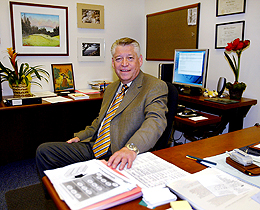|

  
 

|
July 26, 2004
Acting Chancellor Chemers leads $1.5 million federal study of math, science programs
National Institutes of Health funds four-year study of programs that encourage minority students to pursue careers in biomedical research
By Jennifer McNulty
Responding to a critical shortage of young people who are interested in math and science, the federal government is investing $1.5 million at UCSC to identify the strengths of programs that encourage underrepresented minorities to pursue careers in biomedical research.
|

Acting Chancellor Martin M. Chemers in his office
Photo: Dan Coyro
|
The four-year project will be led by Acting Chancellor Martin M. Chemers. It is funded by the National Institute of General Medical Sciences, a component of the National Institutes of Health (NIH).
The scope of need is staggering: The National Science Board estimates the United States will need to prepare 1.9 million workers in the sciences over the next 10 years. In 1998, only 37 percent of undergraduate degrees in science, math, and engineering went to women, and a paltry 12 percent were awarded to underrepresented minorities, including African Americans, Latinos, and Native Americans. The project is part of a larger NIH initiative aimed at understanding the efficacy of educational interventions to promote entry of minority students into careers in biomedical and behavioral research.
UCSC has a long history of sponsoring academic outreach and support programs, and has been a leader in developing programs that encourage students to specialize in math, science, and engineering. University faculty play a vital role in these programs, working with students individually and in groups to help them develop the knowledge, skills, and attitudes needed for success in science. Part of the NIH study will involve assessing students before and after they participate in such programs to hone in on the elements that give students--from high school through graduate study--the greatest boost.
"We need to identify what works in two areas: improving student skills and inspiring them to stay in the fields of math, science, and engineering," said Chemers, a professor of psychology who specializes in leadership and organizational psychology. "We want to weigh the benefits of different program elements, like laboratory internships and faculty mentoring, so we can put our resources where they'll make the biggest difference."
The study will focus on the impact of research and mentoring opportunities on students, looking specifically at the process through which such experiences influence student skills in scientific inquiry and teamwork, their beliefs in their abilities, and their educational and career choices.
Although this project focuses on programs that direct students toward biomedical research careers, Chemers expects the results to be of broad value.
"We're studying programs to bring minorities and women into biomedical research careers, but in the process, we'll be learning a lot about what helps bring outsiders into the fold, and how best to support their leadership aspirations and teamwork," said Chemers. "Our hypothesis is that all students who participate in research and mentoring programs benefit, although we expect to find that those opportunities are particularly important for minorities."
An active researcher and a recognized expert on the cross-cultural and socio-psychological aspects of leadership, Chemers specializes in the role of self-confidence and optimism in leadership. His work suggests that belief in one's own abilities, or self-efficacy, is a strong predictor of motivation, persistence, resilience, and success. Chemers suspects that self-efficacy mediates, to some extent, the ultimate impact these programs have on participants.
"Federal support for the project is particularly welcome in the midst of California's budget crisis, during which the university has made painful cuts to successful outreach programs," said Carrol Moran, executive director of UCSC's Educational Partnership Center (EPC). In five years, the number of underrepresented UC students coming from EPC's six partnership schools has nearly doubled, said Moran. "We know our programs help students get excited and learn more about mathematics and science, but we haven't had the capacity to determine which elements of the program are the most effective," said Moran. "This is an in-depth study designed to find out what works and how."
Joining principal investigator Chemers and Moran on the UCSC research team will be mentoring expert Faye Crosby, a professor of psychology; project coordinator Barbara Goza, director of research and evaluation at EPC; Lisa Hunter, associate director for education and human resources at UCSC's Center for Adaptive Optics; Jerome Shaw, assistant professor of education and a science inquiry expert; and Eileen Zurbriggen, assistant professor of psychology and a statistician. Independent researchers Deborah Kogan and Julie Shattuck are serving as program consultants.
In the first phase of the project, a survey of alumni of various formal support programs will evaluate the impact of those initiatives. Included in the study will be 700 high school students, 500 undergraduates, and 100 graduate students. Those results will be compared to survey data gathered from 500 undergraduate and 100 graduate-level science students who did not participate in such programs.
The research team will also gather qualitative information from program administrators and field observations before moving into the second phase, during which current program participants will be studied. The first group will consist of 280 high school students participating in UC's COSMOS program for high-achieving math and science students, whose science skills and educational goals will be assessed before and after they attend a four-week residential program at UCSC. In the second group, 100 undergraduates involved in science support programs at UCSC will be evaluated at the beginning and end of the 2006-07 academic year.
A long-term goal of the project will be to incorporate the most effective elements into the university's classes so all students will benefit, said project coordinator Goza. "The majority of students who come to the university to study science don't stick with it, yet we hear all the time that employers aren't satisfied with the quality of the American workforce," she said. "We have to do a better job of keeping people in math and the sciences."
Return to Front Page
|
|